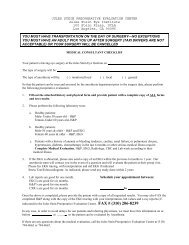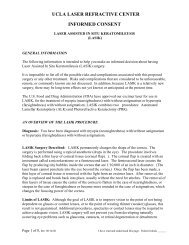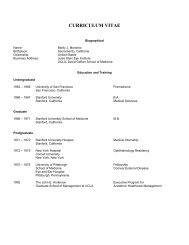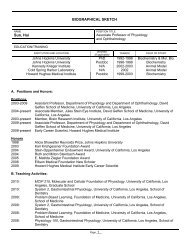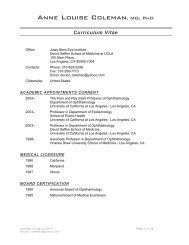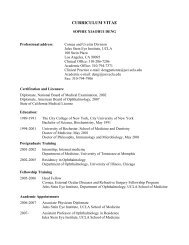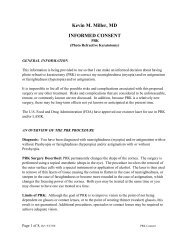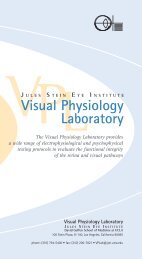View Annual Report - Jules Stein Eye Institute
View Annual Report - Jules Stein Eye Institute
View Annual Report - Jules Stein Eye Institute
You also want an ePaper? Increase the reach of your titles
YUMPU automatically turns print PDFs into web optimized ePapers that Google loves.
Qingling huang, mD<br />
Assistant Research Ophthalmologist<br />
ReseaRch summaRy<br />
Structure and Function<br />
of Alpha-crystallin<br />
Dr. Huang’s research is focused on understanding<br />
the function and structure of alpha-crystallin. Alphacrystallin<br />
is one of the major structure proteins of the<br />
eye lens. This protein is a member of the small heatshock<br />
proteins and is capable of protecting other<br />
proteins from denaturation and aggregations. This<br />
protein is extremely important because it is overexpressed<br />
in many neurological diseases.<br />
Joanna J. Kaylor, PhD<br />
Assistant Research Ophthalmologist<br />
ReseaRch summaRy<br />
Characterization and Identification of<br />
the Enzymes of the Cone Visual Cycle<br />
Bright light vision is solely mediated by the cone<br />
photoreceptor cells of the retina. Recent biochemical<br />
evidence supports the existence of a new metabolic<br />
pathway in the retina for the regeneration of cone opsin<br />
visual pigment. Dr. Kaylor is using biochemistry and<br />
molecular biology techniques to characterize and<br />
identify the enzymes responsible. Her work has led to<br />
the identification of the first vitamin A retinol isomerase,<br />
dihydroceramide desaturase-1 (DES1). Understanding<br />
the role of DES1 in vision is the current focus of<br />
her research.<br />
Jacky m.K. Kwong, PhD<br />
Associate Research Ophthalmologist<br />
ReseaRch summaRy<br />
Degeneration of Retinal Ganglion Cells<br />
and Neuroprotection<br />
Dr. Kwong’s research goal is to identify novel neuroprotective<br />
therapies for glaucoma. To understand the<br />
loss of retinal ganglion cells in glaucoma, his research<br />
focuses on the response and the cell death pathway of<br />
retinal ganglion cells in animal models related to optic<br />
nerve injury and glaucoma. Dr. Kwong and his colleagues<br />
recently found retinal ganglion cell-specific<br />
proteins. He is utilizing these proteins to visualize retinal<br />
ganglion cells and to investigate their function in retinal<br />
ganglion cells during degeneration. He is also applying<br />
pharmacologic techniques to evaluate therapies that<br />
enhance endogenous neuroprotective responses<br />
against glaucomatous, excitotoxic, and axonal damage<br />
to nerve cells, and is utilizing multidisciplinary methods<br />
to understand the protective mechanisms.<br />
anna matynia, PhD<br />
Assistant Research Ophthalmologist<br />
ReseaRch summaRy<br />
Neural and Molecular Basis<br />
of Photoallodynia<br />
Dr. Matynia is investigating the mechanisms of photoallodynia,<br />
a condition in which normal levels of light<br />
produce or enhance ocular or headache pain. Using<br />
a combination of behavioral, molecular, and cellular<br />
approaches in genetic mouse models, the goal is to<br />
identify mechanisms of light-pain association for<br />
different causes of photoallodynia, including corneal,<br />
retinal, and central causes such as dry eye injury,<br />
achromatopsia, and migraine respectively. The research<br />
findings will form the basis of treatment strategies for<br />
this condition.<br />
Faculty 71



